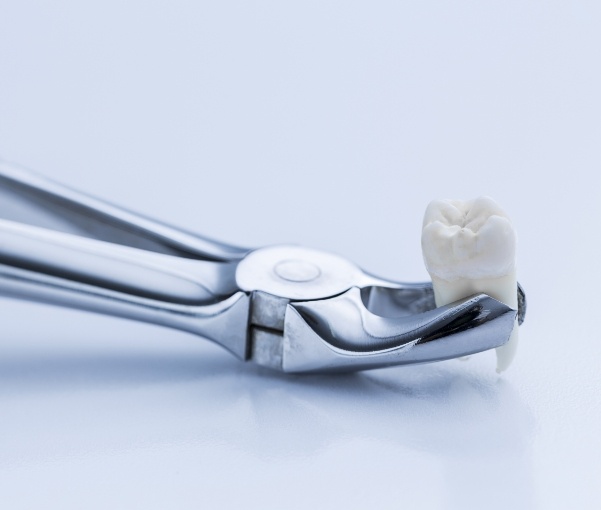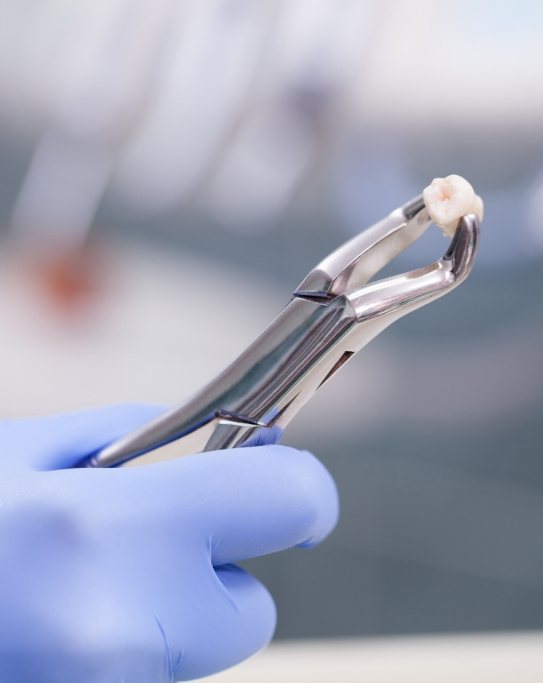Tooth Extractions New York
Saving Your Oral Health From Future Problems

When it comes to saving your oral health from future health problems, Dr. Ira Newman and his team at Gramercy Dental Studio will do everything they can to help you keep your natural teeth. Unfortunately, when this is no longer an option, the tooth must be removed. With tooth extractions in New York, you can expect a smooth and easy procedure. Although you will have a missing tooth, Dr. Newman will happily discuss your options for replacement, allowing you to maintain a healthy, complete smile. To learn more about this type of procedure, and if you need an extraction, contact us today.
Why Choose Gramercy Dental Studio for Tooth Extractions?
- Sedation Dentistry Options Available
- The Wand™ Used for More Comfortable Delivery of Anesthesia
- Your Dental Insurance is Welcome
Why Do I Need a Tooth Extraction?

If you’re wondering why you would ever need to have a tooth removed, here are a few valid reasons your emergency dentist in New York will recommend a tooth extraction:
- Crowded Teeth: If you have teeth that are struggling to erupt but manage to push through into an area with inadequate space, this can lead to serious problems for your smile. Not only can your natural teeth begin to shift and become overcrowded, but, in turn, you will need to resort to orthodontics to realign your bite and move your teeth into the correct position. To do this successfully, Dr. Newman may suggest removing a few of your teeth.
- Periodontal Disease: If gum disease advances beyond gingivitis and causes your bone to deteriorate and teeth to become loose, you might find that a tooth extraction is necessary to eventually replace it.
- Serious Dental Infection: If the pulp, which is the innermost layer of your tooth, becomes infected, a root canal is often suggested. However, if the infection is too severe, Dr. Newman may decide to remove the tooth and replace it once you’ve fully healed.
What Is the Tooth Extraction Procedure Like?

There are two types of tooth extractions: simple and complex. Dr. Newman will begin by examining your tooth and determining which course of action he plans to take to remove it. You will receive local anesthesia to ensure you are comfortable throughout the procedure.
Depending on how your tooth is situated in its socket, Dr. Newman will either use dental instruments to effectively move the tooth back and forth until it detaches, or he will make a small incision in your gums and remove the tooth in pieces if it has yet to erupt. This will make for an easier and smoother procedure.
Post-Operative Tips for a Smooth Recovery

After having a tooth extracted, the last thing you want to occur is a dry socket or infection. To prevent this from happening, Dr. Newman will provide you with some beneficial tips to follow while you are at home recovering. Some of these include:
- Using gauze to bite down on to encourage a blood clot
- Making sure you take your medications and antibiotics as instructed
- Eating only soft foods for the first few days after your procedure
- Getting plenty of rest
- Using a cold compress to reduce swelling and alleviate discomfort
- Maintaining a good oral hygiene routine but being careful around your surgical site
- Forgoing the use of a straw, as any type of suction or spitting can dislodge the clot
Understanding the Cost of Tooth Extractions

While you may need a tooth extraction, you should learn its price before you get it. Doing so helps you grasp whether treatment fits your budget or not. With that said, you’ll need to see Dr. Newman for an exact estimate; the cost of tooth extractions varies. Our team would also work with you to make care affordable, guiding you through its price factors, dental insurance, etc. For more details, please keep reading or call our office soon!
Factors That Can Affect Tooth Extraction Cost
At your consultation visit, Dr. Newman will closely assess your tooth (or teeth). This approach lets us confirm factors that affect your treatment cost, including:
- Extracted Tooth Number – As the number of extracted teeth increases, the treatment price will rise as well.
- Tooth Type/Location – A tooth’s type or location also affects the cost of removal. For example, extracting front teeth is often less costly because it is an easier process.
- Treatment Complexity – Tooth extractions can fall under one of two categories: simple or complex. A simple extraction is easy and often inexpensive, while a complex one tends to be pricey.
- Tooth Replacement Options – Your treatment’s cost will rise if you get a tooth replacement after extraction. Plus, whether you get dentures, dental bridges, or dental implants will affect the level of increase.
Does Dental Insurance Cover Tooth Extractions?
The good news is that dental insurance does cover tooth extractions. Because most plans see removals as crucial, they tend to meet around 50% of an extraction’s cost. Many patients just need to meet their policy’s deductible (or maximum) to enjoy benefits.
Of course, don’t forget that exceptions also exist. There’s a chance your own dental plan has limits, only covers certain teeth, and so on. That being the case, please confirm your benefits before going forward. If you’d like help doing so, our dental team can contact your insurance provider.
How to Make Tooth Extractions Affordable
Even if you don’t have dental insurance, a tooth extraction can still be pretty affordable. You just need to get assistance from our practice’s payment options! At Gramercy Dental Studio, we provide the following:
- Special Offers – Our office currently has a special for emergency visits. By paying $99, you’d get a thorough oral exam, diagnosis, and needed medication prescriptions.
- In-House Membership Plan – You can always join our practice’s in-house membership plan. Through annual payments, it’d give you a sizable discount on tooth extraction.
- Flexible Financing – Our practice works with Cherry Payment Plans. Thanks to their help, a patient can pay for a tooth extraction in monthly installments.
As you can see, your tooth extraction doesn’t need to cause debt. Just visit our office and learn how to better finance it!
Tooth Extractions FAQs
Your natural teeth are designed to last for a lifetime; in fact, tooth enamel is even more durable than bone! Dr. Newman will do his utmost to preserve your natural teeth whenever possible. However, certain circumstances, such as extreme decay or injury, mean that removing the tooth entirely is the best option for the health of your overall smile. If you need a tooth extraction, our Gramercy Dental Studio team will answer any questions you have before your procedure. In the meantime, it may help to read the answers to a handful of questions about tooth extractions in New York that we get asked the most often.
Does Getting a Tooth Extracted Hurt?
Many patients hesitate to complete the treatment their smile needs out of worry that the procedure will hurt. Rest assured that no matter the circumstances of your tooth extraction, the first step we take is always the same: numbing the mouth with local anesthetic. This step reduces your body’s ability to register feelings in your mouth. While you may feel a slight pressure when the tooth is removed, it shouldn’t be outright painful.
Once your procedure is finished and the anesthetic wears off, some soreness and general discomfort are to be expected. To remain as comfortable as possible and minimize post-op complications, make sure to follow our aftercare instructions. If you experience pain that worsens after two to three days or signs of infection (such as fever), please contact us right away.
How Should I Prepare for My Tooth Extraction?
Preparing for your tooth extraction is actually just as important as following your aftercare guidelines. Before your procedure, let Dr. Newman know if you have any questions regarding what to bring, what to eat for breakfast that day, etc. If he has any specific instructions, like picking up prescription medication or consuming nothing but water the morning of, get those taken care of beforehand. We also recommend arranging for someone you trust to drive you to and from our office, as you may be unfit to drive for a few hours after your procedure.
Can I Leave the Space Empty After a Tooth Extraction?
If the extracted tooth was located toward the back of the mouth, you might not see the purpose of replacing it. After all, no one else can see it. However, each tooth works together to create a healthy smile. Even a single missing back tooth can lead to difficulties chewing, which may cause indigestion and poor nutrition.
After you’ve finished healing, we recommend scheduling an appointment with your dentist in New York to go over your tooth replacement options.
What Are My Options for Replacing a Missing Tooth?
Depending on the number of teeth that are being removed and their locations in the mouth, you have a few options for completing your smile, including:
- Dental bridges – With a bridge, dental crowns are secured onto the remaining teeth at either end of the gap, literally “bridging” the space. Dental bridges are ideal for patients who are missing one tooth or a few teeth in a row.
- Dental implants – Considered the superior tooth replacement, dental implants are artificial tooth roots that Dr. Newman surgically places in your jaw. Because they fuse to the jawbone, they can last for 30+ years with the right care. They also look and feel natural, restore more chewing power, and can replace any number of missing teeth.
In the end, the tooth replacement that will best meet your needs is up to you and Dr. Newman.

